I’ve been practicing my hand balancing a lot more lately working on some new moves.
Its fun to see the difference between just working towards a new move for the first time and one that you have mastery of. In fact, just looking at this model I came up with 6 steps between the two (7 if you count zero ground).
0 – This is where you can’t do the move
As much as we want to, there are seldom times that we start off being capable of doing many exercises. No one is born with the ability to stand on their hands (heck, they can’t even stand on their two feet without much trial and error). But you go through the process and eventually gain the skills.
There are a whole bunch of progressions and steps you’ll be working on in order to work up to the given move. Like doing the lead-up stunts will accelerate you reaching the next step in the handstand. Full details can be found in the Secrets of the Handstand Quick Start.
1 – Shakily doing it first time
Wow! Isn’t it amazing the first time you accomplish something you’ve been working on for sometime. But chances are that first success is a bit ugly. Your form isn’t perfect, you might not have exactly the right position, but dammit it was close enough to count. It’s a success in my book.
I remember the first time I hit an aerial. By no means was it perfect and flawless. I used tons of speed ion the takeoff and my landing was low and not in optimal position. But I did do it.
2 – Solidly doing it first time
After you’ve done that first shaky rep or hold, the next time you come back to the gym you will progress to something that is more solid. A better hold or a better looking execution. While some people may have doubted your first rep, there is no doubt here. You’re on your way.
When I was working on the back lever in a straddle I was getting close for sometime. Then one day I hit truly parallel and held for about three seconds. I was elated.

3 – Being able to do it several times.
Now that you’ve got a couple reps or holds under your belt its time to increase the volume. Many times when you hit something for the first time, you only manage one of that day. Sometimes you hit a genuine breakthrough and can all of a sudden skip to this step. Now you do several successful attempts at the exercise in one workout.
4 – Being able to consistently do it.
If it’s a tough move you may not hit it every single day you try. Some days you’re “on” and some days you’re “off”. But at level you’re consistently hitting it all the time, possibly after some warmup drills or lead-up stunts. Along with this your performance improves and your volume increases ever higher.
I’ve started working on a number of bent arm handstand presses recently. In the past my freestanding handstand pushups have been hit or miss. Now they are becoming consistent. Want to learn the steps I used? They can be found in a bonus chapter here.
5 – Doing it any time you desire
Eventually you come to the point where you own the movement. You can do it anytime. Fatigue doesn’t matter. If you were woken up out of bed in the morning, you’d still be able to do the exercise. In your training you’re increasing your timed holds big time or pumping out the reps.
6 – Mastering it and moving onwards
Beyond owning the movement you look to the next step. How can you make this movement harder? What else can you do that will take you to the next level? Basically, where are you going next that will start this process all over?
As my mentor says, “Do the drills and get the skills.” This applies to everything and with this model you may see what you’re working on in new light. Plus if you look between the lines there’s some training tips found within.
Good Luck and Good Hand Balancing,
Logan Christopher
P.S. With my increase in hand balancing practice I’ll have a lot more to write about and share with you, including new courses coming down the line. Stay tuned.








 First a warning. I’ve said this many times before and will continue to say it. You must learn to stand on your hands first, before you start walking around. The reason for this is that if you learn to walk and never to stand, you will only be able to balance by walking around and never learn the necessary wrist and shoulder balance necessary for all other hand balancing.
First a warning. I’ve said this many times before and will continue to say it. You must learn to stand on your hands first, before you start walking around. The reason for this is that if you learn to walk and never to stand, you will only be able to balance by walking around and never learn the necessary wrist and shoulder balance necessary for all other hand balancing.

